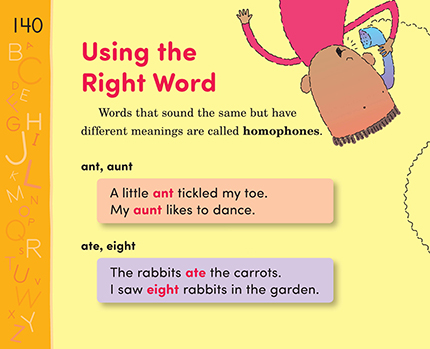Page 140 from

Start-Up Activity
Pages 140–145 focus on words that are easily confused because they sound the same but have different spellings and meanings. Introduce this list by writing the words "ant" and "aunt" on the board. Ask students if anyone knows how to pronounce these words. Then point at "ant" and ask students to tell what the word means. As they do, draw a picture of an ant. Afterward, point to "aunt" and ask students to tell what it means. As they do, draw a picture of a woman who could be someone's aunt. Point out that "ant" and "aunt" can sound the same, but they really are quite different.
Next, write "ate" and "eight" on the board and ask students to pronounce each word. Have them copy the two words on their own paper. Under each word, have them draw a picture of "ate" and "eight." Ask volunteers to share their silly pictures and explain what each word means.
Enrichment Activity: Have students look through the next pages and choose another word pair that they would like to write, define, and draw.
Think About It
“Some ants can carry ten times their weight, but not Aunt Gertrude."

Start-Up Activity
Pages 140–145 focus on words that are easily confused because they sound the same but have different spellings and meanings. Introduce this list by writing the words "ant" and "aunt" on the board. Ask students if anyone knows how to pronounce these words. Then point at "ant" and ask students to tell what the word means. As they do, draw a picture of an ant. Afterward, point to "aunt" and ask students to tell what it means. As they do, draw a picture of a woman who could be someone's aunt. Point out that "ant" and "aunt" can sound the same, but they really are quite different.
Next, write "ate" and "eight" on the board and ask students to pronounce each word. Have them copy the two words on their own paper. Under each word, have them draw a picture of "ate" and "eight." Ask volunteers to share their silly pictures and explain what each word means.
Enrichment Activity: Have students look through the next pages and choose another word pair that they would like to write, define, and draw.
Think About It
“Some ants can carry ten times their weight, but not Aunt Gertrude."